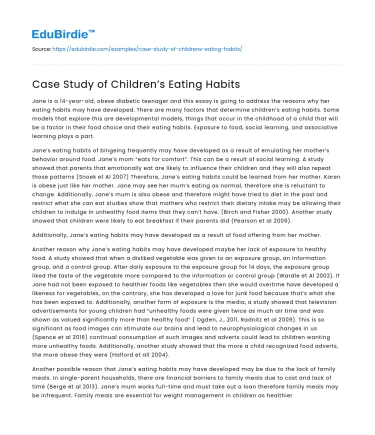Jane is a 14-year-old, obese diabetic teenager and this essay is going to address the reasons why her eating habits may have developed. There are many factors that determine children’s eating habits. Some models that explore this are developmental models, things that occur in the childhood of a child that will be a factor in their food choice and their eating habits. Exposure to food, social learning, and associative learning plays a part.
Jane’s eating habits of bingeing frequently may have developed as a result of emulating her mother’s behavior around food. Jane’s mom “eats for comfort”. This can be a result of social learning. A study showed that parents that emotionally eat are likely to influence their children and they will also repeat those patterns (Snoek et Al 2007) Therefore, Jane’s eating habits could be learned from her mother. Karen is obese just like her mother. Jane may see her mum’s eating as normal, therefore she is reluctant to change. Additionally, Jane’s mum is also obese and therefore might have tried to diet in the past and restrict what she can eat studies show that mothers who restrict their dietary intake may be allowing their children to indulge in unhealthy food items that they can’t have. (Birch and Fisher 2000). Another study showed that children were likely to eat breakfast if their parents did (Pearson et al 2009).
Save your time!
We can take care of your essay
- Proper editing and formatting
- Free revision, title page, and bibliography
- Flexible prices and money-back guarantee
Additionally, Jane’s eating habits may have developed as a result of food offering from her mother.
Another reason why Jane’s eating habits may have developed maybe her lack of exposure to healthy food. A study showed that when a disliked vegetable was given to an exposure group, an information group, and a control group. After daily exposure to the exposure group for 14 days, the exposure group liked the taste of the vegetable more compared to the information or control group (Wardle et Al 2003). If Jane had not been exposed to healthier foods like vegetables then she would overtime have developed a likeness for vegetables, on the contrary, she has developed a love for junk food because that’s what she has been exposed to. Additionally, another form of exposure is the media, a study showed that television advertisements for young children had “unhealthy foods were given twice as much air time and was shown as valued significantly more than healthy food” ( Ogden, J., 2011, Radnitz et al 2009). This is so significant as food images can stimulate our brains and lead to neurophysiological changes in us (Spence et al 2016) continual consumption of such images and adverts could lead to children wanting more unhealthy foods. Additionally, another study showed that the more a child recognized food adverts, the more obese they were (Halford et all 2004).
Another possible reason that Jane’s eating habits may have developed may be due to the lack of family meals. In single-parent households, there are financial barriers to family meals due to cost and lack of time (Berge et al 2013). Jane’s mum works full-time and must take out a loan therefore family meals may be infrequent. Family meals are essential for weight management in children as healthier meals are normally eaten, for connection and communication, leading to the overall well-being of a child. (McCullough et al 2016). Therefore, bingeing could be a result of a lack of family meals and non-mindful eating as Jane eats while watching television, therefore it is easy to eat past satiety and binge. Her mom’s work schedule leaves Jane more freedom in choosing what and when to eat therefore she has more access to unhealthy food.
A psychophysiological reason for Jane’s eating habits could be due to stress eating. In teenagers, a lot of changes occur in the body that can lead to stress. Peer pressure, Low self-esteem, comparison to others, and being overweight can be stressors for Jane. In obese people, stress can lead to excess eating (Pine,1985) and can lead to weight gain in children (Bradley,1985). Psychophysiological model theories highlight food and the emotional link. Jane sees food as more than energy for her body and relies on it for more than she should. Her low self-esteem as she compares herself to her peers can trigger sad feelings which can then trigger a binge leading Jane to be in a vicious cycle of bingeing. Food can reduce depression and increase serotonin levels (Myrte Esther Hamburg 2014).
Another reason for Jane’s eating habits could be peer conformity. This is explored in the cognitive model of social norms. A peer study showed that overweight girls ate more when sat next to overweight girls than when sat next to girls of normal weight (Salvy et al 2007) Jane may eat the way she does to fit in with her peers as typical teenage diet patterns include eating fast food and snacking which are high in fat, sugar and salt and low in essential nutrients. (Gregory & Lowe, 2000, Livingstone, 1998). )
A complex reason why unhealthy eating habits may occur is that it plays a vital role in most aspects of our lives, we need them to survive, and they can be used to show love, during celebrations for example. Food offerings can make people closer as friendships or romantic relationships where food is shared are thought to have a closer connection. Food offerings can release positive feelings in both the giver and the receiver. If food offering starts to become the primary way to show love then it can lead to eating disorders in children as they start to see food as an object to cope with many situations. (Hamburg 2014)






 Stuck on your essay?
Stuck on your essay?

